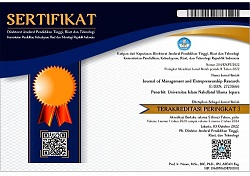Sustainable Retail Financing in Turbulent and Difficult Market Conditions: A Dynamic Capability Perspective
Abstract
Objective: This study aims to identify the dynamic capabilities (DC) that have been owned by the company and find new measurements of DC instruments for financing companies. Dynamic capability is needed to react quickly to the dynamics of the industrial environment, survive in competition and be sustainable. Research Design & Methods: This study utilized a quantitative approach. The search for factor values of each DC was conducted through 32 questionnaire questions given to 55 branch business managers. KMO and Bartlett's test and rotated component matrix test were conducted to prove that the factors are interrelated, with the limitation of average value as the main factor determinant. Findings: Sustainability, innovation, and dynamic factors are important capabilities for multi-finance companies that need to be strengthened and developed. Implications & Recommendations: The concept of DC sensing, seizing, and reconfiguring is closely related to the capabilities of strategic human resource development (SHRD) which is the most important asset. In the future, research can be conducted again on how strong the relationship between SHRD dynamic capabilities and existing DC factors is in achieving company sustainability. Contribution & Value Added: Organizations can survive in fierce competition if they know their DC as their competitive advantage. However, not many companies know how to measure their DC against their dynamic industry, this study will provide examples of the instruments needed.
Downloads
Copyright (c) 2023 Journal of Management and Entrepreneurship Research

This work is licensed under a Creative Commons Attribution 4.0 International License.
























